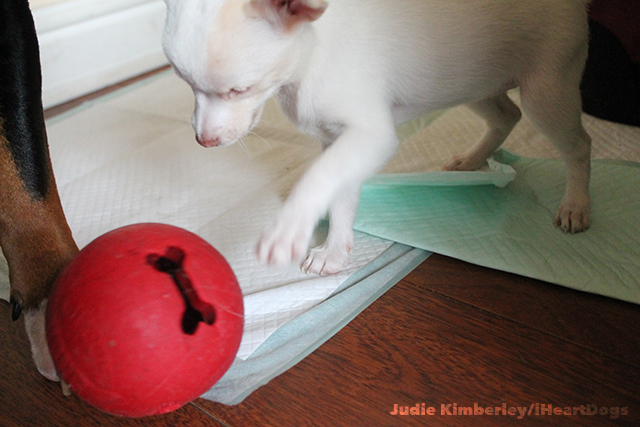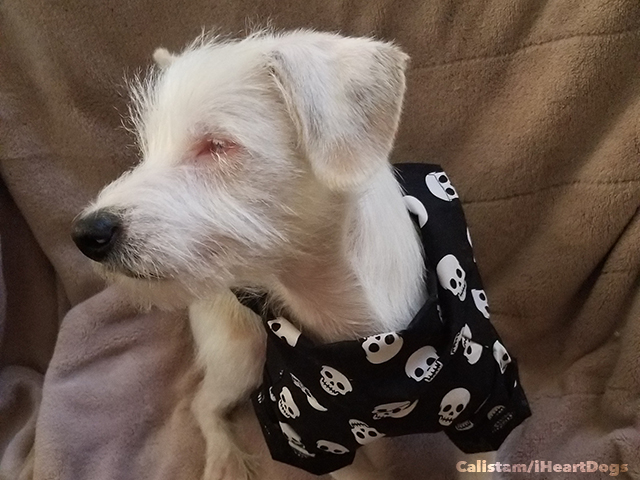One of the most heartwarming things we hear about dogs with special needs is that they never seem to notice that they’re any different. However, living with a blind dog does come with challenges, and although your dog doesn’t need to know he’s handicapped, it’s best to take precautions for his safety and comfort. A blind dog can live a perfectly happy, full life, but without his sight he may need some help getting around.
Luckily, our dogs are quick learners and extremely adaptable. With a little effort and training, you can help your dog get around your home confidently and comfortably.
1. Safety First
As your dog gets used to navigating your home without his vision, make his safety your top priority. If you have features in your home that may be a danger (like stairs, a fireplace, or a pool) they should be blocked off so he doesn’t accidentally take a tumble. Sharp edges, like those on coffee tables or a raised hearth should be cushioned.
Baby proofing companies make products that are extremely useful for special needs dogs. Baby gates can keep your dog from falling down your stairs, and free-standing ones are available if you don’t have anywhere to put one that uses tension to stand. You can also purchase cushioned strips to dull sharp edges.
While your dog is learning a new way to navigate your home, put him on a leash and walk him through a few times a day until he seems comfortable and less hesitant. It may take some time and accidents are likely to happen, but with a consistent layout, he should gain the confidence to move freely around his home.
Of course, should you ever move or rearrange your furniture, you’ll need to help your dog learn the new layout. If possible, keeping your current furniture exactly where it is will be most comfortable for your blind pup.
As your dog learns to rely less on his vision, help him lean on his other senses to navigate.
2. Verbal Cues:
You can offer your dog a lot of help by training him to understand verbal cues. Teaching your dog cues like “stop,” “wait,” “step up/step down,” “left,” and “right” can save him a few bumps and bruises and keep him on the right path when you go for walks.
If you’re fortunate enough to know that your dog is going blind before he gets there, begin right away to get a head start on training. If you’re the kind of amazing person who is welcoming an already-blind dog into your home, you can still train him, but may need to change your strategy to accommodate him.
You can get started learning helpful cues and how to train your blind dog at BlindDogTraining.com.
3. Tactile Cues:
Many pup parents to blind dogs use tactile cues to help their dogs know where they are in their homes. Carpet runners placed along the walkways of your home can help keep your dog from running into walls or help him find his way if he gets lost or turned around.
A common solution for stairs is to place a rug with a distinctive texture at the top, so when your dog feels the change beneath his feet, he knows to be careful – that the step down is nearby. The same can be done for doorways with a step down or any area in your home where your dog should use caution. But until your dog learns what these new textures mean, it’s best to keep any potentially dangerous areas blocked off when he’s navigating alone.
4. Sound Cues:
Dogs have excellent hearing, and many dogs will rely on this sense should they go blind. A bubbling water bowl is one of the first purchases many owners make when they adopt a blind dog – the noise is frequent but unobtrusive and will help your dog find it easily. It can also help him find his food if you always keep his food dish nearby in the same place.
You can also use sound to let your dog know where you are. Some people put small bells on their shoes so that their dogs can follow the noise to find them wherever they might be. Many will clap or snap when entering or leaving a room so their dog isn’t startled if they didn’t know they were there. If you have hardwood floors, just wearing shoes with soles that make a little noise can be a big comfort to your blind dog.
Your dog will still want to play, and will enjoy the same toys he did before he lost his vision. You can purchase balls that jingle or rattle, and chew or soft toys that squeak, so it’s easier for him to keep track of where they are during playtime.
This is also a good time to start announcing your arrival home with a happy, “Honey! I’m home!”
5. Scent Cues:
Dogs also have an exceptional sense of smell, and you can use this to your blind pup’s advantage too. If you already keep candles or fragrances in your home, consider using different scents in each room or near important items so your dog has another cue to use for navigation.
The smells don’t have to be strong and they don’t have to be in every room. Joanna, who adopted blind dog Migoi, says that even though she bought him a bubbling water bowl, she also put scented candles near other bowls in their home so Migoi could use any bowl that was convenient. Your dog can also associate scents with things like “the room where my bed is,” “the room with the door to the backyard,” or “the room where my food is.”
Remember: certain scented objects or chemicals are poisonous to pets. Consider pet-friendly options if you’d like to use scent cues.
Your blind dog has a wonderful life ahead of him full of every happiness any other dog could have. Your dog doesn’t need to see to love you and bring you joy. Take time to help him adjust and give him the confidence to get around, and he’ll show you his thanks a thousand times over.










